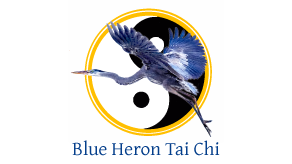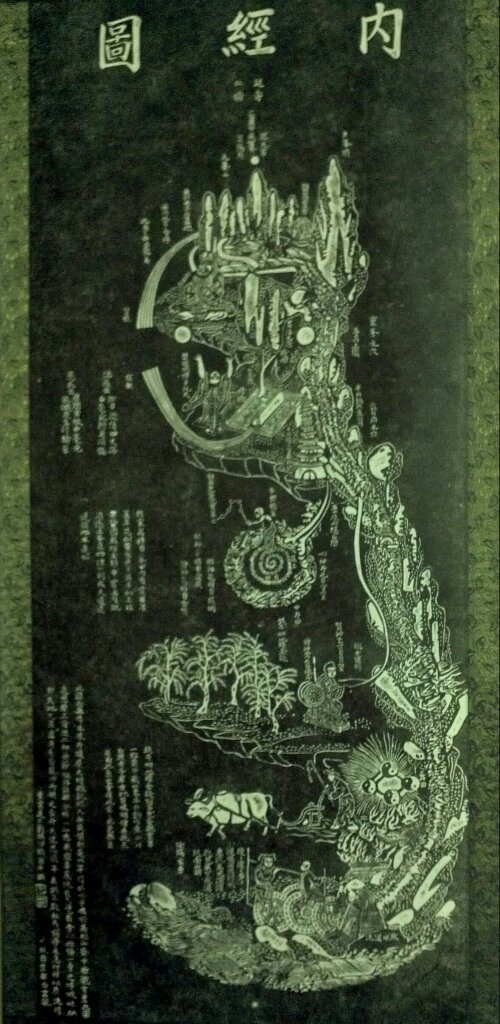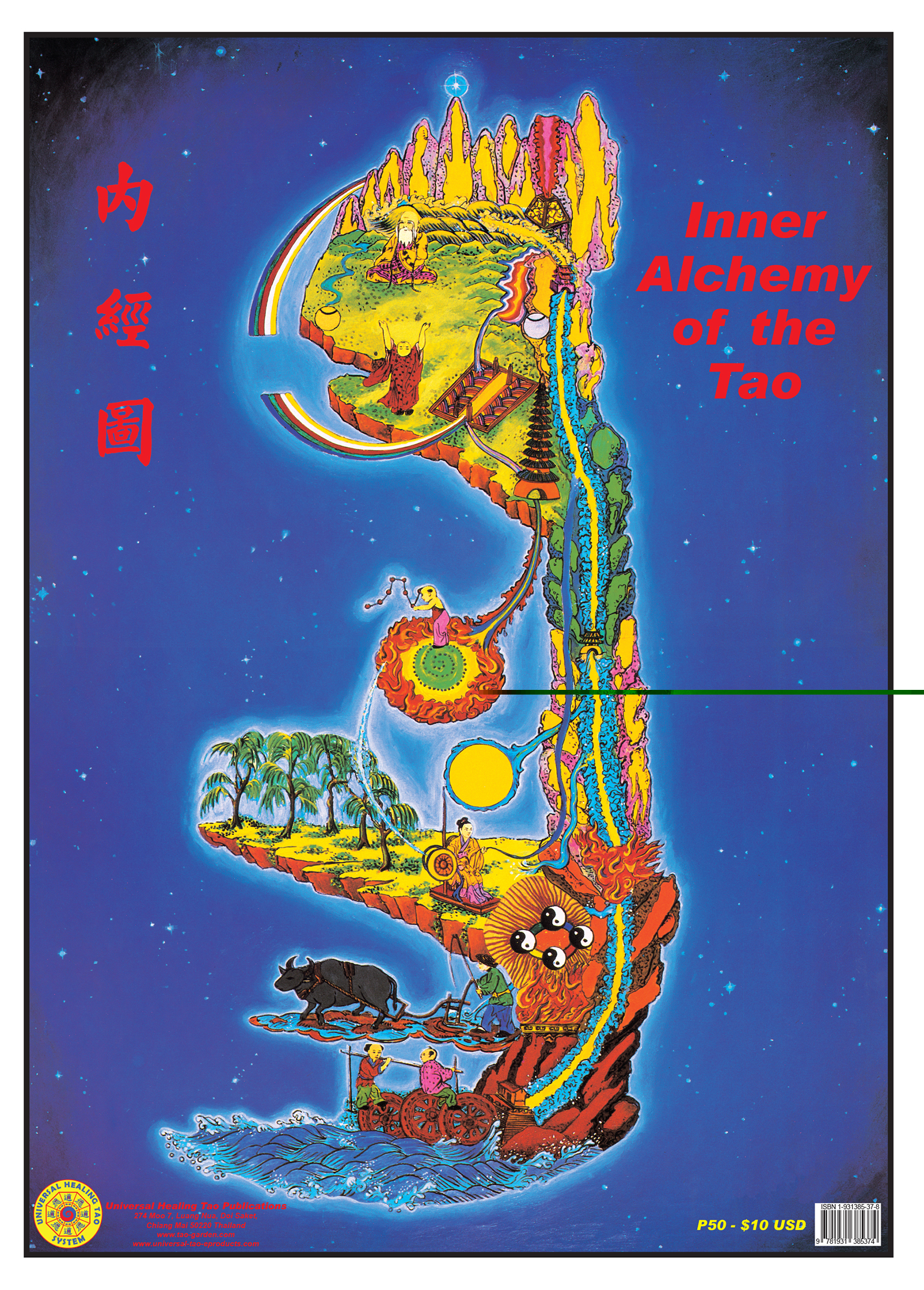It took me a while to track this down. The Chinese names for this image have been variously translated as:
Diagram of the Internal Texture of Man
Diagram of the Inner Scripture
Chart of the Inner Passageways
Diagram of Internal Pathways
Chart of the Inner Warp
Chart of the Inner Landscape
Chart of Inner Luminosity
None of which I thought of when I was doing a Google search.
This image comes from an engraved stele dated 1886 in the Beijing White Cloud Temple by Liu Chengyin, who based it on a silk scroll discovered in the Shaolin temple library on Mount Song in the Henan Province. Another similar scroll exists from the Qing Dynasty (1644 – 1912), found in the Palace of Fulfilled Wishes in the Forbidden City. Notice that the legend for the image is written right there for all to see. At first I thought the Chinese conceit of putting text in a painting took away from the “purity” of the painting. Comes from the western cultural norm of not putting any distractions with the possible exception of the painter’s signature, in the picture. Now, especially for drawings like this with lots of symbols, and analogies, I find the text quite helpful.
Someone at Mantak Chia’s organization in Thailand, with access to Photoshop, created a color version which is quite nice and gives contrast, so you can see more detail.
This version makes all the gates much more visible, and for some reason, adds a Spleen.
The image portrays both a sitting meditator and a fetus. I have been looking for the descriptions and meanings of all the symbols in the image. It is much easier for those who can read Chinese because the legends are written right there for all to see. Us English only folks have to depend on translations. Which, it seems, aren’t that easy to track down.
Beginning at the bottom and working up, the symbolisms have been interpreted by various scholars and Ken Cohen, in his book Qigong.
Two children, a boy and a girl work the treadmill waterwheels. They represent yin and yang, and also the left and right kidneys which generate water and sexual energy. They are reversing the flow of the water and sexual energy, pumping it up the spine to the brain and recharging the body with vitality. In meditation practice, this is one part of the Micro Cosmic Orbit.
Next, we see a man plowing the field with oxen. The inscription on the stele says: the iron ox ploughs the field where coins of gold are sewn. Gold coins are a symbol of long life and wisdom. To achieve this takes the perseverance of a farmer and the strength of an ox. The earth also represents Qi acquired through a balanced diet and harmonious lifestyle.
The four circular yin yang symbols suspended above a boiling cauldron represent the lower Dantian. By cultivating the Qi in the Dantian and practicing proper breathing techniques, the internal energy begins to cook. Eventually it steams, healing, repairing and energizing the body. The four yin yang symbols radiate energy in all directions.
The weaving maid (Zhinü) and the boy (Niulang) above her represent an interesting story and a special day in Chinese culture. The boy is a cowherd, and the maid is a fairy. The maid’s job in heaven was to weave colorful clouds. She became bored with her work and came to earth to seek adventure. She met the cowherd and the soon fell in love. They married and had two children. The Goddess of Heaven found out about the escape and ordered Zhinü to return to heaven. Niulang’s ox suddenly acquired the power of speech. It told Niulang that if he killed him and hid inside his hide, he could sneak into heaven. Niulang shed many tears, but finally killed his ox, made the skin and made his way undercover with his two children into heaven to be with their mother. Again, the Goddess of Heaven found out about the subterfuge (how is it that people always think they can hide things from the Goddess of Heaven?) and was furious. The Goddess turned the two lovers into the stars Altair and Vega and took out her hairpin and scored a wide river in heaven, which became the Milky Way, to keep the lovers apart. Once a year the stars approach each other, and on that day, the seventh day of the seventh lunar month, the magpies fly up to heaven and make a bridge so the lovers can be with each other for a single night. (In western cosmology, instead of a magpie, the constellation is known as Cygnus the Swan.) The seventh day of the seventh month is the Chinese equivalent of our Valentine’s Day.
Meanwhile, back at the Chart of Inner Luminosity, the cowherd is using the big dipper to gather Qi from the universe. The Big Dipper makes a complete rotation every year and so doing, gathers Qi from throughout the universe. The cowherd sends this energy via a celestial bridge to the weaving fairy. She weaves the Qi and sends it up the spine where the energy is incorporated into the meditation practice. This tells us as meditators to absorb Qi from the cosmos and seek harmony.
The twelve-tiered Pagoda is the throat and the back of the neck. The Qi must flow freely up through the pagoda to reach the pinnacle of meditation. One meaning of the pagoda is to have a loftier view of your surroundings and not worry about the details.
To the left of the pagoda is the rectangular reflecting pool. The pool is the mouth and saliva. The bridge is the tongue. In the drawing the word drawbridge appears next to the tongue. The drawbridge can raise and lower to make contact with the upper palate to join the Governing and Conception channels. Saliva is secreted during meditation and absorbs Qi. The meditator swallows the saliva all the way down to the Dantian.
In the center of the head are two circles, representing the eyes and/or the sun and the moon. When meditating, these lights are turned inward, illuminating the inner world.
There are two figures in the head. Lao Tzu and Bodhidharma. These two sages are the founders of Taoism and Zen Buddhism They represent the importance of meditation and also display the harmonious unity of different spiritual paths that lead to the same goal.
Above the two sages are the sacred peaks. Hermits and enlightened beings climb to the tops of mountains and enter caves to meditate. Mountains are funnels that attract heavenly energy. The illustration points out that the sacred caves aren’t just at the tops of mountains, but within your own head.
At the top of the head are the words: “Nirvana,” “Realm of the Sages,” and “Longevity.” These are the goals of meditation.


